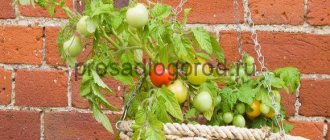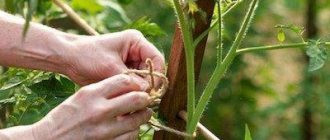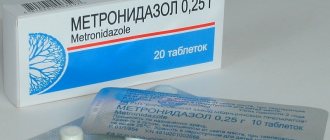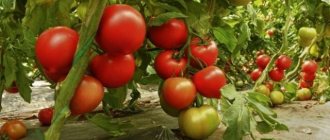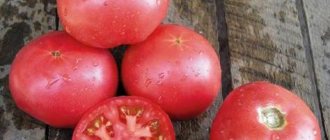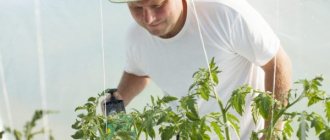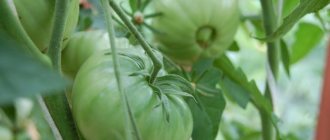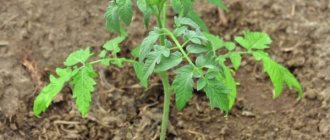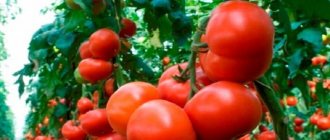» Vegetable growing » Tomatoes » Rules for spraying tomatoes with copper sulfate
0
9046
Article rating
Spraying tomatoes with copper sulfate is one of the care procedures. This substance is used to increase crop immunity and increase productivity. There is only one drawback - there is a risk of burning the leaves if you overdo it.
- Instructions for use
- Time spending
- Prevention
- Recommendations for preparing the solution
- Dry use
- Spraying procedure
- Security measures
- Greenhouse treatment
- Technology
- Treatment at the time of greenhouse construction
Rules for spraying tomatoes with copper sulfate
Late blight - know the enemy by sight!
Phytophthora of tomatoes is a fungal disease. It appears as irregularly shaped spots with pale green edges and a white mold-like coating on the back of the leaf that appears in rainy weather.
Signs of late blight include the presence of infrequent or continuous stripes of dark brown color on stems and leaf petioles. During the dry period, the affected areas dry out, and in high humidity they rot.
In unfavorable weather, the invasion of late blight on tomatoes begins as early as June. Phytophthora multiplies exponentially at air humidity of 90% and temperature of +20 degrees. She especially loves wet weather with sudden changes in temperature, that is, when a cool night is followed by a warm, cloudy day.
Symptoms of late blight on tomatoes
The development of the disease begins from the above-ground parts of tomatoes. The color of the lower or upper branches changes, depending on how the infection occurred. Mushroom spores can fly into the garden with the wind, or they can, after remaining in the ground for a long time, awaken.
Brown areas on the stems indicate that they have attached themselves to the cells of the plant and are absorbing its sap. It soon turns out that all the branches are already infected. Irregular yellow spots appear on the leaves. They become deformed, dry out in places of damage, and curl.
If the fruits have already formed by this time, damaged, putrefactive areas of black, brown or yellow color also appear on them. Unripe tomatoes stop growing.
Why is it dangerous for tomatoes?
A particular danger of late blight is its rapid reproduction. After only 3-4 days, all the plants in the garden are affected. The bushes darken and wither.
Crop losses can be catastrophic. Fruits affected by rot are not suitable for food either fresh or for preservation.
Pathogen spores accumulate in the soil, threatening future tomato plantings.
Is it possible to spray tomatoes with copper sulfate against late blight?
The substance is used for the treatment and prevention of late blight, as well as white spot, downy mildew and other fungi. It has antiseptic and fungicidal properties. However, before using it according to the instructions, you need to correctly assess the condition of the tomatoes and what the composition of the soil is: perhaps it already contains a lot of copper, and an overdose is very harmful, the fruits may turn black.
Characteristics of the drug
Copper sulfate is an inorganic substance in the form of light blue crystals. Water, which dissolves this copper sulfate salt well, also turns the same color.
To combat tomato diseases, specialized stores offer copper sulfate in plastic (less often glass) containers with a capacity of 100 to 500 grams. The product is stored in the absence of light and high humidity to avoid loss of physical and technical characteristics.
It is recommended to use copper sulfate as an effective and cheap fertilizer both in household plots and in large agricultural enterprises.
Important! Copper for plants is a catalyst for oxidative and metabolic processes, and the absence of problems with late blight does not negate the need for its use.
Release form and cost
Copper sulfate for treating tomatoes against late blight can be found on sale in the following forms:
- In the form of a dry powder, packaged in plastic bags or bottles. This packaging of vitriol is intended not only for growing vegetables, but also for other purposes (for example, builders etch moldy corners of rooms with vitriol solution during repairs, and technicians use it for galvanic treatment of copper surfaces.). Vitriol powder is packaged in bags from 100 g to 25 kg.
- In the form of a concentrate for the preparation of Bordeaux mixture. In this case, it is packaged in plastic bottles with a volume of usually about 500 ml.
The cost of vitriol is about 300 rubles per bottle of Bordeaux mixture concentrate and from 130 to 200 rubles per 1 kg of powder. The price varies depending on the quality of purification and concentration.
How it works
The fungicidal effect of copper sulfate is based on the interaction of copper ions with protein and enzyme complexes of cells. These biochemical reactions cause irreversible changes and denaturation of proteins, which leads to the death of fungal spores.
In what cases is it used?
A solution of copper sulfate is used to treat tomatoes when there is a threat of late blight. However, besides this, this drug helps fight a number of other diseases:
- White spotting.
- Scab.
- Downy mildew, etc.
In addition, a solution of copper sulfate is an additional fertilizer for tomatoes. A lack of copper, especially in peaty and sandy soils, can lead to chlorosis and leaf curling. To avoid this, plants should be fed with a solution of vitriol.
Copper sulfate is used:
- Preventatively, even before late blight appears on tomatoes.
- As a means to combat existing signs of late blight.
Purposes of use
Feeding tomatoes with copper sulfate has different effects on the plant, it depends on the initial purpose of application.
The product can be called universal; it is used to treat diseases, disinfect soil and bushes, and replenish the active ingredient – copper.
Let's look at everything in order.
Treatment
Treating tomatoes with vitriol helps in the treatment of fungal diseases:
- scab;
- white and brown spotting;
- moniliosis;
- powdery and downy mildew;
- late blight.
For these purposes, take a 3% solution (300 g of substance per 10 liters of water).
Copper replenishment
If tomatoes are planted on acidic, peaty or sandy soils, they will develop a copper deficiency. Literally after 3 feedings, the reserves of this microelement will be replenished in the plants, due to which the soil will become fertile.
Soil preparation
To dilute copper sulfate for processing tomatoes, all you need is water and a sieve. If you plan to only fertilize the soil, use dry powder at the rate of one gram per square meter.
The most optimal ratio recommended by many manufacturers is ten liters of water and one hundred grams of the substance. If you need less liquid, the amount of vitriol also needs to be reduced proportionally - fifty grams is enough for five liters and so on. By the way, do not use glass or enamel containers to prepare the solution.
Here's what's important when landing:
- The soil is preferably sandy or loamy with an acidity of about 6 pH.
- In spring, the earth loosens and fills with oxygen.
- Disinfectants are added against fungal and viral diseases, insect eggs and fungal spores.
Soil suitable for gardening contains pathogens of fungal diseases. Therefore, it is important to prevent late blight disease in vegetable crops, destroy diseased bushes in a timely manner and disinfect the soil.
Tomato processing time
The product is used for prevention before signs of fungi appear. In this case, the use of copper sulfate in gardening for tomatoes against late blight will require a less concentrated solution and less frequent treatments than when the development of the fungus has already begun.
Gardeners who have been procrastinating with prevention are wondering whether it is possible to spray tomatoes during fruiting with copper sulfate in the spring. This is undesirable, and if such a need arises, the last treatment should take place at least a week before harvesting the fruits.
It is also not recommended to carry out the procedure during flowering, because with the slightest violation of technology and dose, the bush can shed its ovaries.
Housewives often have a problem: “I burned tomatoes with copper sulfate, how can I save them?” The affected parts of the plant are not restored and must be destroyed.
Treating tomatoes with copper sulfate and lime not only helps against late blight. It normalizes the composition of the soil when the soil is acidic - tomatoes do not like high acidity. Foliar feeding of tomatoes is also possible. Plants are sprayed with a weak solution if there is not enough copper in the soil.
Flaws
Despite its established authority among farmers, there are some negative aspects to this compound. First of all, a copper solution can easily harm your plants if you prepare the mixture incorrectly and take too much of the active ingredient. The crop will get burns, and further harvest will simply be inedible due to interaction with the toxin.
The main advantages of copper sulfate are:
- prolonged action - tomatoes will be protected for up to 1 month after treatment;
- multidisciplinary application, which allows you to cope with diseases and viruses 100%, covering not only tomato seedlings, but also the planting site;
- low cost;
- economical consumption of substances;
- the ability to spray bushes with fruits and eat them after a minimum period of time.
About
How to prepare the solution correctly?
The dosage depends on the purpose of spraying: for prevention, a weaker agent is prepared, for the fight against fungus, a more powerful one is prepared. There is another method - preparing Bordeaux mixture.
For the main solution, dilute 50 g of powder in a small container with water and mix thoroughly until completely dissolved, then pour into a container with five liters of water. This will form the basis. Treatment of tomatoes against late blight in open ground with copper sulfate is carried out with one percent or three percent solutions based on this concentrate.
The strongest, three percent, solution is applied to the soil before planting, and the weakest is used to treat the tomatoes with copper sulfate during flowering. During this period, the bush is vulnerable, so the product cannot be used unless absolutely necessary, and the dosage must be strictly observed so as not to wonder what to do if tomatoes are burned with copper sulfate.
The prepared solution must be used on the same day: it will no longer be suitable the next day.
Dosage and proportions
To treat the soil and the plant itself against late blight, different doses of copper sulfate are used:
- soaking seeds - 0.01–0.05%. Use 1 g per 10 liters of water;
- spraying of the ground part - 0.1%. To obtain it, take 10 g of copper sulfate per 10 liters of water;
- soil disinfection and tomato planting - 1%: 100 g diluted in 10 liters of water;
- for a better effect on the soil (especially if late blight has occurred) and when sowing seeds - from 3%. To obtain a 3% solution, 300 g are diluted in 3 liters of warm water, then poured into a 10-liter bucket and another 7 liters are added.
Step-by-step preparation
To prepare a 1% solution of copper sulfate, you need:
- Dilute 100 g of blue crystal powder in a plastic container. For dilution, use 1 liter of water heated to 40°C.
- Dissolve the resulting solution in a 10-liter bucket, pouring 9 liters of water into it.
- If necessary, strain through cheesecloth.
Important! The solution retains all its properties for 9 hours. The next day it will no longer be suitable.
Copper sulfate for tomatoes: application
In gardening and agriculture, copper sulfate is used as a protective contact fungicide. In addition to its fungicidal properties, copper sulfate also exhibits a bactericidal effect. It is effective against a wide range of fungal and bacterial diseases of various crops.
Copper sulfate in its chemical composition is a combination of 1 molecule of inorganic copper sulfate salt with 5 molecules of water.
It is blue crystals or crystalline powder, soluble in water.
Copper sulfate, like other copper-containing preparations, is valued for its
- unsurpassed protective properties,
- ability to eradicate diseases,
- wide spectrum of action against various diseases,
- lack of resistance in pathogens to these drugs.
Over more than a century of gardening practice, copper sulfate as a fungicide has not lost its relevance to this day.
An aqueous solution of copper sulfate of any concentration is characterized by an acidic reaction, and therefore it is phytotoxic to vegetative crops, i.e. may cause leaf burns and fruit damage.
Phytotoxicity is especially pronounced in vegetable crops.
Copper sulfate must be handled with great care due to its high toxicity to humans and the environment.
Copper sulfate for tomato diseases
Copper sulfate solution in its pure form is not used against diseases on tomatoes, as it can seriously harm the plants. Bordeaux mixture is prepared for processing.
When used correctly, copper sulfate in the form of a Bordeaux mixture protects against diseases:
- Alternaria blight (macrosporium blight),
- late blight,
- spots,
- bacteriosis.
Copper sulfate against late blight and alternaria blight of tomatoes
Late blight and Alternaria are very aggressive diseases, which is why the main defense is built against them.
- Tomatoes in open ground should be treated against late blight before the onset of rainy weather, as well as weather with sharp changes in day and night temperatures.
- The duration of the protective effect of treatment against late blight under such conditions, as a rule, does not exceed 7-10 days.
- After this period, the treatment should be repeated.
- You can use Bordeaux mixture again, but it is better to alternate with drugs from other chemical classes.
- Treatment of tomatoes with Bordeaux mixture is allowed up to 4 times per season.
- Treatment with Bordeaux mixture must be completed at least 2 weeks before harvest.
Bordeaux mixture of copper sulfate
A solution of copper sulfate in its pure form is not used during the growing season on sensitive crops - vegetables, flowers, ornamentals, etc. A fungicidal mixture - Bordeaux mixture - is prepared on the basis of copper sulfate.
Bordeaux mixture has all the fungicidal properties of the original substance, but has a milder effect on crops.
How to make Bordeaux mixture
- In order to neutralize the excess acidity of the copper sulfate solution, add a suspension of quicklime.
- A properly prepared solution should have a neutral or slightly alkaline reaction.
Prevention
Prevention of tomatoes from late blight and other diseases is carried out in several stages.
- During the period of soil preparation for planting seedlings. The soil is watered with a light solution (30 g per 10 liters of water). A sprayer is used for processing to better distribute the drug.
- For watering planting holes during transplantation into open ground. 1 liter of solution (20 g per 5 liters of water) is poured into each well. After this, at the stage of fruit formation, the culture is sprayed with Bordeaux mixture (50 g per 6 liters of water).
Treatment of tomatoes with copper sulfate against late blight
In general, the use of solutions of this chemical protective agent can be divided into 3 stages.
First
The substrate for seedlings is sprayed with a three percent solution using a sprayer, and the planting containers are wiped with the same. One-time processing.
Second
A day before picking the seedlings, the soil prepared for this purpose is watered with a one percent solution. If the soil for picking was purchased in a store, you can skip this step.
Third
A day before transplanting the bushes to a permanent place, make holes in the garden bed and pour a liter of solution into each at a concentration of 1%.
When the tomatoes begin to set, during their ripening period, they are sprayed with a weak (no more than 0.2%) solution of Bordeaux mixture. It is prepared like this. Pour 150-200 g of lime with five liters of water and stir thoroughly. In another container, 100 g of vitriol is dissolved in five liters of water. Next, the copper sulfate solution is carefully poured into the lime solution.
Seed treatment
To get rid of late blight spores and other pathogenic microorganisms, tomato seeds are pickled with a weak (0.1%) solution of copper sulfate.
The seeds are soaked in the solution for a day. Then take it out, rinse thoroughly with running water and dry, making sure that they do not stick together.
How to treat a greenhouse?
For prevention, it is enough to make a 0.75-1% solution. They wash all walls and other surfaces with it.
If there are pests or fungi, the surfaces should be washed with a two percent solution twice at short intervals.
Wooden panels are treated with a 7% compound.
Features of soil treatment
The use of copper sulfate for tomatoes in the garden and in the greenhouse is carried out before planting seedlings. Dilute 5 g of powder in a proportion of 10 liters of water and spray the ground with 2 liters per 1 square meter. m. If the tomatoes have already suffered from late blight, treat the soil with a three percent solution a week before transplanting.
Use for prevention
If late blight has not appeared yet, this is not a reason to calm down. To be sure, you should use the vitriol solution as follows:
- For soaking seeds (about 15 minutes in a weak solution).
- For etching the soil.
- For pre-spraying.
How to apply the product as a fertilizer
Copper sulfate is often recommended for use in soils such as sandstone or peat, as well as soils that have a poor composition. To eliminate the lack of copper in the soil, it is necessary to add the designated chemical substance at the rate of 1 gram per 1 square meter. But the indicated fertilizing should be carried out no more than once a year. For soil that has a different composition, it is advisable to apply such fertilizer approximately once every 5 years.
It is not recommended to apply iron sulfate directly to growing bushes, as it can burn the root system. The best option would be to add iron sulfate along with compost when digging the soil in the fall. Thus, the soil will be saturated with the designated microelement over the winter and will be able to provide the plants with the necessary substances in the spring.
What to do in case of overdose
Uncontrolled use of copper sulfate and other copper-containing preparations leads to the accumulation and excess of copper in the soil.
Poisoning of tomatoes occurs, which manifests itself in the form of chlorosis of leaves:
- the processes of chlorophyll formation are disrupted, photosynthesis activity decreases;
- leaves turn yellow prematurely and fall off.
If such symptoms appear shortly after treating the plantings with copper sulfate:
- Water the beds once with a large amount of water (10–12 liters per 1 m2). This will help transfer excess minerals to deeper layers of soil.
- Stop using copper-containing drugs and use other means against late blight (for example, Fitosporin, Planriz, Furacilin).
Rules and time for treating tomatoes with copper sulfate against late blight
The area is processed in dry weather. If it rains a few hours after this, there will be no effect from the work performed, and the entire procedure will have to be repeated.
It is best to spray in the morning or evening, when there is no sunlight, otherwise exposure to the sun will cause copper sulfate to cause burns on the leaves and shoots of tomatoes, which will lead to the death of the plant.
The copper sulfate solution is quickly washed off from the surface of the leaves even with small sediments. In order for copper sulfate to remain on the surface of plants longer, various adhesives are added to it. Bordeaux mixture is copper sulfate with an adhesive, which is slaked lime. There are other ready-made copper preparations with adhesives, for example Abiga-Pik.
Spraying procedure
The most common application is spraying tomatoes.
For the fight to be effective, the area must be treated according to the following scheme:
- spraying the soil a few days before planting;
- treatment of bushes during the growing season;
- spraying formed tomatoes.
The first stage is carried out in cloudy weather, when the likelihood of precipitation is low. If it rains after treatment, you will have to repeat the procedure using a light solution (10 g per 10 liters of water) after planting.
Do not water at the roots. The substance should only fall on leaves and shoots.
You can also spray tomatoes with Bordeaux mixture - take 1% substance in the amount of 100 g per 10 liters of water. This substance consists of copper sulfate and slaked lime. The difference is that it is slightly aggressive due to the presence of limestone. This has a positive effect on the quality of the plant, because does not cause burns.
The effect of copper sulfate on tomatoes does not last long compared to other crops. Treatment with copper preparations is stopped 3 weeks before harvest.
Security measures
Copper sulfate is also dangerous for humans. To protect yourself from negative consequences, take safety precautions.
- When preparing the solution, wear thick rubber gloves and eye glasses.
- Wear long sleeves during all preparations and spraying to protect your skin from burns.
- When working with this substance, avoid drinking cigarettes, drinking water, or eating food.
- If the product gets on an open area of skin or mucous membrane, immediately rinse the area with cold running water. The longer you wash the affected area, the lower the risk of burns.
If you use the substance in small quantities, toxicity will not accumulate in tomatoes. In case of overdose, there is a risk of poisoning from the collected fruits.
The insecticide belongs to the category of chemical substances, so adhere to the following rules:
- the treatment procedure is carried out with a spray bottle or a soft brush with long bristles;
- store the finished composition for no more than 3 hours;
- Keep children and pets away from the area where you are preparing the chemical.
The use of copper preparations in higher concentrations than required leads to leaf burns. This manifests itself in the fact that the edges of the leaves become brown, a brown mesh appears on the leaves, the leaves warp and may fall off. When preparing solutions, many gardeners rely on the volume of the bucket, which, in their opinion, has a volume of 10 liters. But buckets can have different volumes! It is better to use a graduated measuring cup when preparing the solution.
Precautionary measures
When using both ferrous sulfate and copper sulfate, it is necessary to protect your eyes and respiratory tract, and wear rubber gloves on your hands. Fungicides can burn the skin and cause irritation. If you get it on your face, you should wash it immediately. The solution must be prepared in a respirator. Vitriol products are dangerous for bees when insects fly out en masse to collect nectar. Such drugs should be stored away from food, in a place inaccessible to children.
Copper is not absorbed into the fruits; cucumbers and melons can be consumed 5 days after processing the leaves. They just need to be rinsed with running water.
Precautions when working with the drug
It should be remembered: copper sulfate is a substance of class III hazard. Despite the relatively low toxicity for humans (the lethal dose for an adult is about 10 g), poisoning is possible, so the following rules should be observed when working:
- The solution must be prepared only in a separate container. Once used for eating, it should no longer be used.
- Contact with solutions and dry vitriol should only be done with rubber gloves.
- When spraying plants, you should wear safety glasses and, if possible, a respirator or gauze bandage to avoid inhaling the spray sprayed in the air.
- The vitriol solution should be applied pointwise. Its use is permissible only in small garden plots; this drug is not used in the industrial cultivation of tomatoes.
- After completing the treatment, you should wash the exposed skin with soap and, if possible, change clothes and take a shower.
During spraying, there should be only one person in the work area - the gardener himself with the sprayer. Neither strangers nor animals should be there at this time.
Additional Tips
Gardening specialists give the following recommendations for the use of copper sulfate against late blight of tomatoes:
- it is advisable not to use the chemical after the formation of buds on tomato bushes;
- if late blight has already manifested itself on tomatoes, then copper-containing preparations are simply necessary;
- If late blight has severely affected a tomato bush, then treatment with chemicals will no longer help. It is better to tear out such a bush and dispose of it completely;
- if burns appear on the leaves after spraying, it is better to tear them off, since such foliage will not recover;
- Spraying should not be carried out in rainy weather or before downpours. For this, dry, windless weather with air temperatures up to +30°C will be ideal. It is better to disinfect greenhouse soil in the autumn;
- You cannot prepare the solution in reserve or leave it for the next day, as it is not stored;
- carry out treatment with this chemical in the greenhouse with the doors open.
And more about the drug
In addition to tomatoes, vitriol solution is used in gardening for processing grapes and for disinfecting saw cuts when pruning fruit trees. It is also useful for pre-planting treatment of potato tubers.
In addition to the vegetable garden, orchard and greenhouse, copper sulfate will also be useful in household work. It (especially in combination with chlorine-containing preparations) perfectly kills mold in damp corners of buildings, basements, and sheds.
Copper sulfate is an effective remedy for controlling late blight on tomatoes. However, it is important to observe the dosage, timing of application, solution concentration and safety rules when using this chemical.
Tomato varieties resistant to late blight
There are tomato varieties that are naturally resistant to phytosporosis. It’s easy to choose the option that is most suitable for the greenhouse or beds.
Among them there are giant varieties, with massive branches, and miniature, compact ones. The shape of the fruit can be fantastically beautiful or very practical. They will add confusion if you already have a favorite variety.
They will become the wind of change. They will allow you to take a break from stereotypes. These include:
- Tomato Top Ten. A low-growing hybrid with exotic yellow fruits, early ripening. Used for preparing salads and canning, it has an excellent taste.
- Grape. Mid-season variety with small red tomatoes, bush height up to 2 m. The clusters are spectacular, reminiscent of an ear.
- Lady fingers. A very popular option. Tomatoes are similar to berries. The bush is undersized. Refers to unpretentious varieties.
- Dietary big man. An original variety with large orange fruits, branches up to 1.5 m in height. High-yielding, early ripening.
- Zhigalo. The height of the bush is up to 0.5 m. The color of the fruit is red.
- Asvon. The bush is miniature. Doesn't need tying. It grows no more than 45 cm in height. The fruits are small, red in color, and ripen 95-100 days after planting.
- Compact Kakadu variety with large red fruits and early harvest.
- Leningradsky early ripening. It bears fruit 85-100 days after completion of planting. The tomatoes are small, red, juicy.
Many other varieties have high levels of late blight resistance. By choosing one of them, you can forget about this trouble. However, if potatoes or another crop that is attractive to a harmful microorganism grows nearby, problems still cannot be avoided. The tomato plantation will survive, but the potato plantation will not.
It is important to carry out preventive spraying in a timely manner. Cut infected leaves, tubers, and rhizomes must be burned and the compost treated with copper sulfate or similar preparations.
It is advisable to grow companion plants nearby, green manure. The country and every family needs food supplies. Tomatoes are one of the main products in the human diet. These measures will save you from losses and unnecessary expenses.
Analogs
Although vitriol solution and Bordeaux mixture are time-tested remedies, there is now a wide selection of antifungal drugs to combat late blight. These include, in particular:
- "Zineb", zinc universal fungicide. Zinc, like copper, is a heavy metal that inhibits the development of mycelium and destroys spores.
- "Previkur" - this drug is effective in the early stages of late blight. It is also used for prevention.
- "Bravo", "Kuproksat". They can be used at any stage, if the fruits themselves are not yet affected.
- “Fitosporin-M”, “Fitophtorin” are systemic biological products used at the seedling stage.
